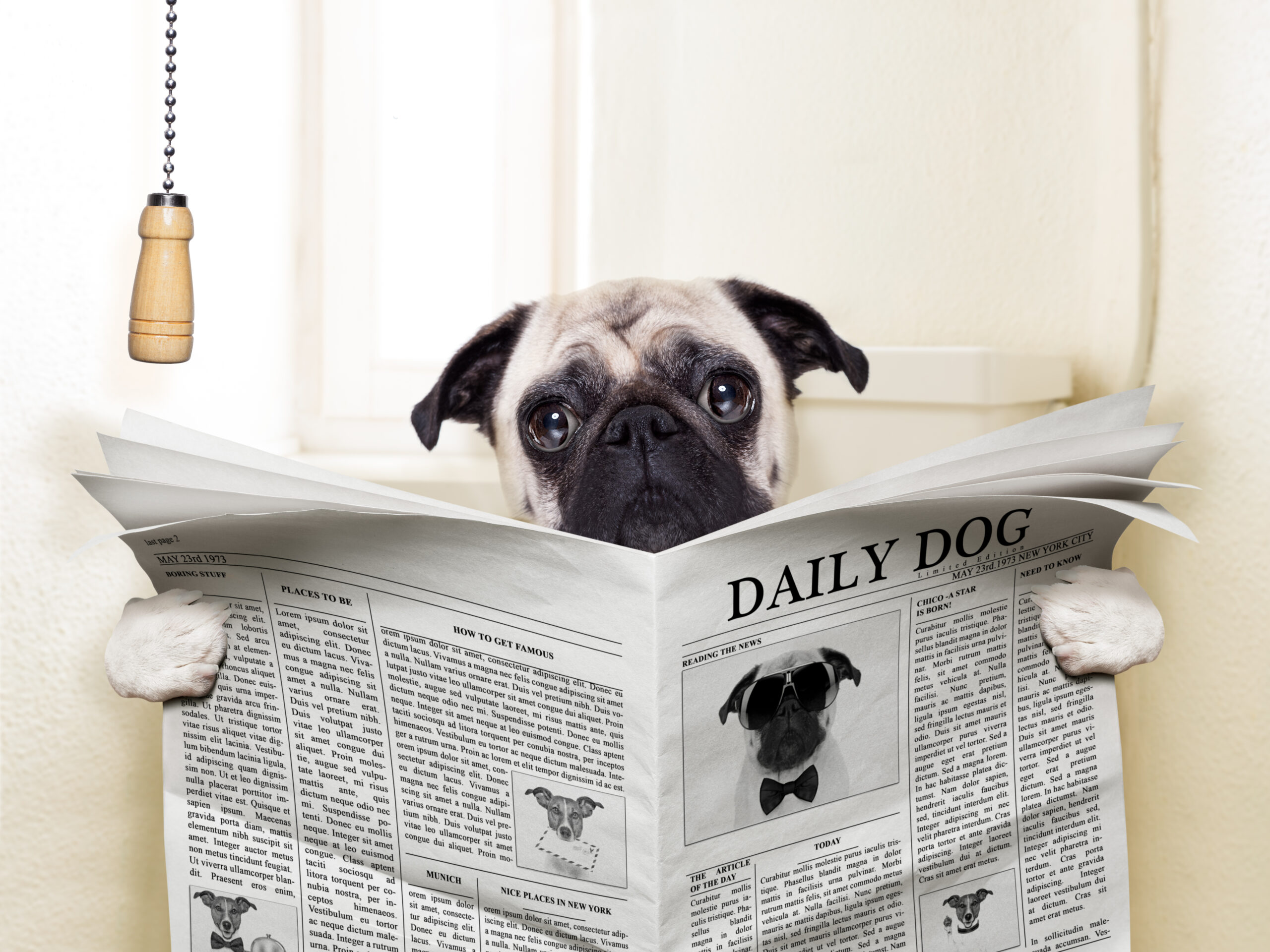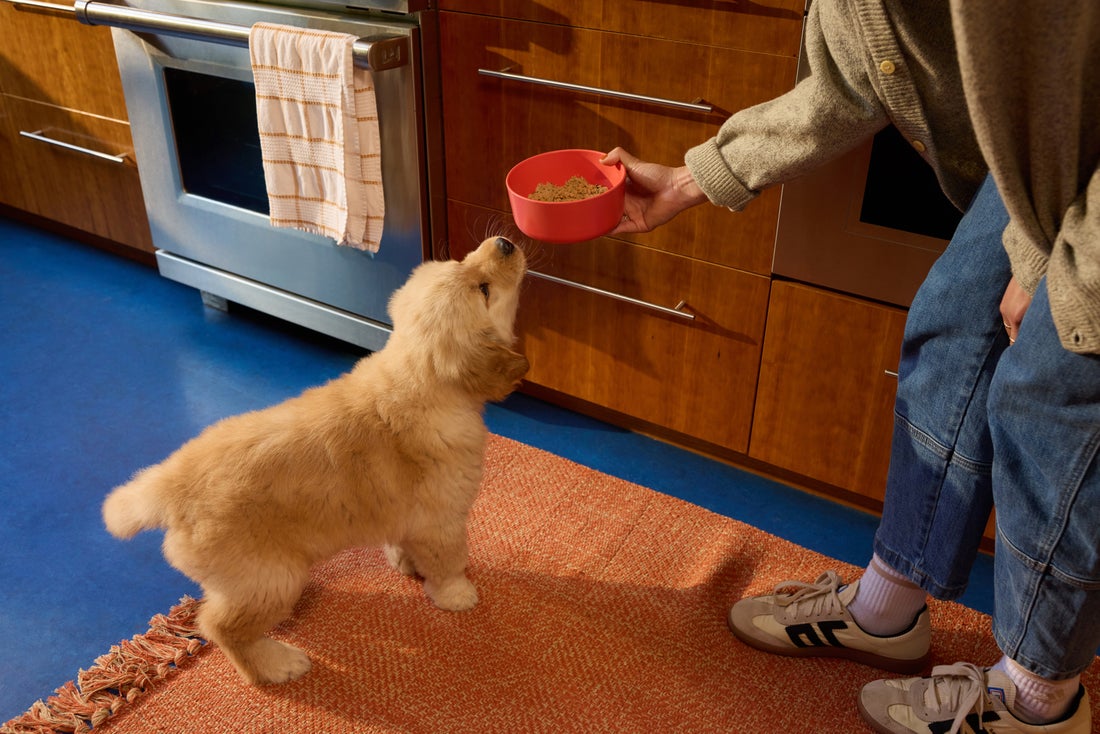Hey Ollie blog readers! We’re offering you an exclusive 60% OFF your starter box! Try now!
A constipated dog is no fun for anyone. When your dog has trouble going number two, it can cause stress for you—and constipation can be uncomfortable, painful, and even dangerous for your pup. If you are concerned that your dog might be constipated, here’s exactly what to do.
What Is Dog Constipation?
Dog constipation occurs when a dog has difficulty passing stool or hasn’t had a bowel movement for an unusually long time. While a healthy dog typically poops once or twice a day, a constipated dog may strain, produce hard, dry stools, or not poop at all.
Constipation happens when stool moves too slowly through the digestive tract, causing it to become dry and compacted. This can result from dehydration, lack of fiber, insufficient exercise, or an underlying health issue. In some cases, dogs may strain to defecate but only pass small amounts of mucus or nothing at all.
Occasional constipation is common and usually resolves with minor dietary or lifestyle adjustments. However, if a dog is frequently constipated or goes more than 48 hours without pooping, it could indicate a more serious issue, such as an intestinal blockage or neurological disorder. Long-term constipation can also lead to a condition called megacolon, where the colon becomes enlarged and unable to push stool out effectively.
If your dog is struggling to poop, monitoring their behavior and stool consistency can help determine whether they need home remedies or veterinary attention. Understanding the causes and symptoms of constipation early can prevent discomfort and potential complications for your pup.
Is My Dog Constipated? 4 Signs & Symptoms
Much like in humans, constipation is not a difficult condition to diagnose in dogs. There are four central symptoms of constipation in pups:
- It’s been two days or longer and your dog hasn’t had a bowel movement.
- Your dog seems to have trouble going number two or yelps and cries when defecating (also known as Dyschezia.
- Your dog’s poop is very hard, dry, and crumbly.
- Your dog is only able to pass small amounts of liquid or bloody stool.
What Should I Do If My Dog is Constipated?
The best thing to do when your dog can’t go to the bathroom is to try to treat the most common causes first. If it’s been less than three days and your dog doesn’t seem to be in serious pain, try these solutions:
- Snack on pumpkin or fig. Most dogs enjoy the taste of the superfood pumpkin and it’s a great source of dietary fiber, which has shown to alleviate both constipation and diarrhea. Try feeding your dog pureed pumpkin or making one of these healthy pumpkin treats. One study, published in 2011, found that naturally high-fiber fig paste was also able to alleviate constipation in Beagles.
- Fill up the water bowl. Make sure your dog is properly hydrated by giving him plenty of water to get the bowels going.
- Get active. Physical movement can help lead to bowel movement, so take your dog for a little jog, head to the dog park, go for a brisk walk, or try a dog-friendly workouts.
If these methods don’t work, or if your dog hasn’t pooped in more than two to three days, it’s time to consult your veterinarian. They can rule out underlying issues and may recommend:
- Stool softeners or laxatives
- Enemas (only to be administered by a professional)
- Prescription medications
- Further diagnostic tests if a more serious condition is suspected
Ways to Prevent Dog Constipation
To prevent constipation in dogs, consider implementing these strategies:
- Provide a balanced, high-fiber diet appropriate for your dog’s needs.
- Ensure constant access to fresh, clean water to maintain proper hydration.
- Establish a regular exercise routine with daily walks or playtime to stimulate bowel movements.
- Maintain a healthy weight for your dog
- Restrict access to indigestible items like gravel, dirt, and plants that could cause blockages.
- Schedule regular veterinary check-ups to catch and address potential health issues early.
- Consider adding fiber-rich foods like pumpkin puree (100% pure, not pie filling) to your dog’s diet.
- For older dogs, discuss with your vet about switching to a higher fiber diet.
- Avoid giving your dog bones, which can cause digestive blockages.
- Have your dog neutered at an early age to prevent prostate growth, which can lead to constipation.
- Groom your dog regularly to prevent matting around the anus.
- If your dog is on medication, discuss potential side effects with your vet and how to manage them.
What Causes Dog Constipation?
There are many reasons that your dog might be straining to defecate. However, the most common reasons are linked to diet, hydration, and activity level.
- Diet: Too little or too much fiber in your dog’s diet.
- Dehydration: Your dog isn’t drinking enough water.
- Lack of exercise: Your dog is too sedentary.
If it’s only been a few days and your pet doesn’t appear to be in pain, it’s likely due to one of those three reasons, which means it can easily be both treated and prevented. However, constipation can also signal a more serious condition. Less common reasons for dog constipation include …
- Blockages caused by your dog eating indigestible items like corn cobs, kitty litter, gravel, and dirt.
- Self-grooming to the extent that too much fur is digested, causing a blockage.
- Stress created by dramatic changes or negative issues in your dog’s environment.
- Tumors in our around the digestive tract, rectum, or anus that physically prevent stool from passing.
- Enlarged prostate, which pushes on the rectum, caused by Benign Prostatic Hyperplasia, cysts, infection, or, in rare cases, cancer.
- Medications, which list constipation as a potential side effect.
- Anal sac disorders.
- Hypothyroidism (aka low thyroid hormone production).
- Orthopedic issues, especially around the pelvis, which can make it painful or impossible for your dog to squat.
Can Dog Constipation Be Dangerous?
While occasional mild constipation is common, be alert for signs of more serious conditions. Severe constipation, known as obstipation, can lead to megacolon—a condition where the colon becomes enlarged and unable to function properly. This may require surgical intervention.
Always consult your veterinarian if constipation persists for more than a few days or is accompanied by other concerning symptoms.
Remember, a healthy dog is a regular dog! By focusing on a balanced diet, proper hydration, and regular exercise, you can help keep your furry friend’s digestive system running smoothly.
Dog Constipation Home Remedies
If your dog is mildly constipated, there are several safe and effective home remedies to help get things moving again. Since constipation is often caused by dehydration, diet, or lack of exercise, addressing these factors can provide quick relief.
- Increase Hydration – Make sure your dog is drinking plenty of water throughout the day. If they’re reluctant to drink, try adding low-sodium bone broth or water to their food to boost moisture intake.
- Add Fiber to Their Diet – A small amount of canned pumpkin (plain, not spiced), psyllium husk, or cooked sweet potato can help soften stool and promote regularity. Start with 1 teaspoon for small dogs and up to 1 tablespoon for large dogs.
- Offer a Stool Softener – A small amount of plain canned pumpkin or unflavored, sugar-free Metamucil can help regulate digestion. Always check with your vet for the correct dosage.
- Encourage Exercise – Regular movement helps stimulate the digestive system. Taking your dog on longer walks or engaging in active play can naturally encourage bowel movements.
- Try a Gentle Belly Massage – Lightly massaging your dog’s stomach in circular motions may help stimulate intestinal movement and relieve mild constipation.
If your dog hasn’t pooped in more than 48 hours or is straining without success, home remedies may not be enough, and it’s time to explore other treatment options.
Dog Constipation Treatment
If home remedies don’t work or your dog is experiencing ongoing constipation, your veterinarian may recommend additional treatments to help restore normal bowel movements.
- Prescription Stool Softeners or Laxatives – Vets may prescribe lactulose, docusate sodium, or other stool softeners to ease constipation. These medications help draw water into the intestines, making stool easier to pass.
- Dietary Adjustments – A vet may suggest switching to a high-fiber dog food or incorporating more moisture-rich foods into your dog’s meals. In some cases, probiotics can help improve gut health and regulate digestion.
- Enemas – In severe cases, a vet may administer an enema to clear out hardened stool. Never attempt to give your dog an enema at home without veterinary guidance, as improper use can cause injury.
- Manual Removal – If constipation has led to an impacted colon, a veterinarian may need to manually remove the hardened stool under sedation.
- Treating Underlying Conditions – If constipation is caused by a medical issue like megacolon, neurological disorders, or an obstruction, your vet will determine the best treatment plan, which may include medication or surgery.
Veterinary treatment is especially important if constipation is chronic or accompanied by pain, vomiting, or lethargy.
When to See a Veterinarian
While occasional constipation is normal, there are times when veterinary care is necessary. You should contact your vet if your dog:
- Hasn’t pooped for more than 48 hours
- Strains excessively without passing stool
- Shows signs of pain (whimpering, reluctance to move, hunched posture)
- Has vomiting or loss of appetite along with constipation
- Passes blood or mucus instead of normal stool
- Has a swollen or bloated abdomen
Chronic constipation can indicate an underlying issue like intestinal blockages, neurological conditions, or dehydration from kidney disease, all of which require professional treatment. If your dog is in distress or their condition worsens, seeking veterinary care as soon as possible can prevent serious complications and keep your pup feeling their best.
The Ollie blog is devoted to helping pet parents lead healthier lives with their pups. If you want to learn more about our fresh, human-grade food, check out MyOllie.com.
Tagged As:

The nutrition your dog needs,
the food they want.

Enjoying our articles? Subscribe our Newsletters and get new articles directly to your inbox
You might also like
11 September 2025
5 MINS READ
Avoiding Common Dog Food Allergies
No pup parent wants to see their dog struggle through the discomfort and complications that come with food allergies. While food allergies affect just 0.2 percent of dogs according to Banfield Pet…
by Ollie Pets
11 September 2025
5 MINS READ
Signs Your Dog Loves Their Food
When it comes to food and nutrition, most concerns focus on feeding quantities, the quality of ingredients, and maintaining a healthy weight. But have you ever wondered if your dog is actually enj…
by Ollie Pets
26 August 2025
8 MINS READ
Why Is My Senior Dog Shaking?
You’re sitting with your dog and notice something strange. Their body is trembling. It’s subtle at first, but then the shaking becomes more noticeable. Maybe it’s in their legs, or their who…
by Ollie Pets







